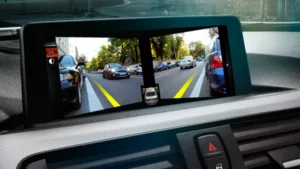IHS Markit has released a new report highlighting the potential for display technology to make a huge impact on road safety, by replacing traditional side and rear-view mirrors with high-definition cameras. In its new Camera and Display Mirrors report, IHS estimates that the demand for this technology will grow over the next ten years.
Rear-view mirror displays are not a new phenomenon. General Motors first implemented the technology in its Cadillac line, with Chevrolet following soon after and Buick next in line. Nissan has also announced plans to add the tech to its 2018 Armada line, with other car-makers sure to follow suit.
Side view mirror display – Image:BMW
According to its global forecasts, sales of rear-view mirror displays are estimated to reach 1.8 million by 2025, led by Japan and North American markets.
Digital rear and side-view mirror displays have an edge over conventional mirrors due to their increased field of view and elimination of blind spots caused by rear-seat passengers or roof pillars. The removal of side-view mirrors will also improve vehicle aerodynamics, thereby enhancing fuel efficiency, irrespective of which kind of fuel is used.
Meanwhile, production of side-view mirror displays is predicted to amp up over the next 1-2 years, with half a million estimated to be in use by 2025.
The report goes on to speculate that 1.8 million cars will be produced in 2025 with the new technology built-in, while 23% of those will eschew conventional wing mirrors altogether.
Brian Rhodes, automotive technology analyst with IHS, said:
“Suppliers and automakers are investigating several different ways to replicate the camera view with an in-vehicle display. These side-view images could feed through an instrument cluster display of some sort, or even a traditional center stack display.
However, the majority of concepts to this point have focused on new, dedicated side-view displays located either in the door panels or A-pillars because they offer the driver the most familiar line of sight for this safety-critical aspect of driving”.
Analyst Comment
We published the press release that we put out and there was an interesting comment from a reader about the problems that a change might cause in needing a switch in the driver’s focus, which might cause ergonomic problems. I’m not entirely sure this is a real problem as the displays for the ‘mirrors’ are likely to be at the same distance from the viewer as the instrument panel, so it’s hard to see how this would add to the problem. (BR)

